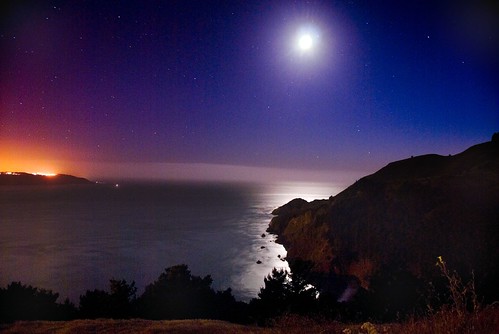This is a photograph looking away from the Golden Gate Bridge out the Golden Gate towards the open ocean. On the right you can see Point Bonita. If you look hard in the larger version of this photo, you can see the Point Bonita light. On the left, there’s a boat, Point Lobos and Land’s End, and the ambient lights of the Sunset district of San Francisco.
I was photographing the Golden Gate Bridge after dark. I turned round, and saw this beautiful moonscape. I thought I might as well try to capture it, although you never know what you are going to get with these kinds of exposures. A key point: I used the menus on my Nikon D200 to turn on the long exposure compensation since this image was exposed for thirty seconds.
I like best the way the stars appear in the nighttime sky.
I processed the RAW original four times in Photoshop to come up with the version you see here. First, I created exposures for the sky and ocean. I added them as layers, and used a layer mask and a gradient to combine the two layers.
Next, I processed the RAW file a third time to expose properly for the moonlight reflected on the water. I combined this layer with what I had already done using a layer mask filled with black (hiding everything). I painted on the black layer mask with a white brush set to varying opacities to bring out the reflected moonlight. I used less opacity and flow towards the edges of the area I wanted to bring in, and more towards the center.
Finally, the moon itself needed some work. In fact, the moon was much brighter than anything else in the image. So I did a fourth RAW conversion to expose for the moon. This meant boosting the shadow slider, dropping the brightness slider, and lowering exposure as far as it would go. I then used the same layer mask painting technique as I used with the reflected moonlight, with concentric rings of greater opacity towards the center of moon.
While it was not trivial to shoot this image in the field, the main issues there were things like getting my tripod set up in the dark, not falling off a cliff, and so on. It’s a fair statement that most of the intellectual effort with this photo took place in the post-processing.
Also true: what I “saw” when I took the photo was beautiful, but it did not “look like” my final image. A couple of reasons: the camera sensor picks up light spectrum that is invisible to the the human eye. And my post-processing resulted in an image with a greater range from light to dark than any conventional photograph could have rendered from the scene.

Pingback: Photoblog 2.0: » Photoblog 2.0 Archive: » Golden Golden Gate Bridge
Pingback: Photoblog 2.0: » Photoblog 2.0 Archive: » Night for Day
Pingback: Photoblog 2.0: » Photoblog 2.0 Archive: » Dream Sky